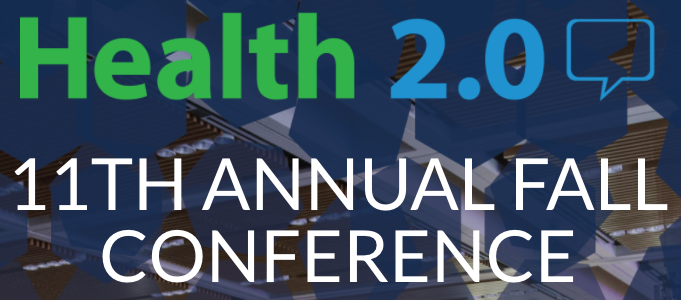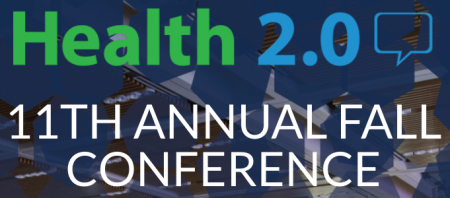
The future of effective and efficient healthcare will be underpinned by artful combinations of both digital technologies and “analog humans,” if the first day of the Health 2.0 Conference is a good predictor.
Big thoughts about a decentralized future in healthcare kicked off Day 1 of the 11th annual Health 2.0 Conference in Santa Clara, CA. The co-founders of Health 2.0 (H20), Matthew Holt and Indu Subaiya, explained the five drivers of the tech-enabled health future.
1. The new interoperability, underpinned by FHIR standards and blockchain. “FHIR” stands for fast healthcare interoperability resources, which are informatics standards that enable data to move seamlessly from different sources to healthcare environments like electronic health records systems and apps.
2. Augmented reality and virtual reality (AR and VR). These will provide new modalities for data transactions and services. Dr. Simon Kos of Microsoft demonstrated the company’s HoloLens technology using “mixed reality” which is currently deployed at Case Western’s medical school to replace traditional anatomy learning via cadaver.
3. New entrants, redefining what counts as a health company. Aside form Amazon, Apple, Facebook and Google, look at the Ritual vitamin company serving up a health experience for women, Habit in the food industrybaby food industry, and Manifest, established by the founder of CrossFit. These start-ups and others are disrupting traditional legacy health providers — or will they complement or augment hospitals, physicians, and suppliers to the industry.
4. Business model disruption. Aneesh Chopra talked about “PayViders” during the day, where health care providers are morphing into payors integrating health financing with healthcare provision (THINK Kaiser-Permanente as the quintessential model). Some of the companies with new business models in this space include Parsley, Crossover Health, Oscar, Clover, and Bright, among others being introduced on a weekly basis it seems. For some of these disruptors, technology itself becomes the service. A third model covers technology services that are morphing into clinical services, like Livongo, Omada, Grand Rounds, MySugr, VIDA, and Glooko — all of whom could add physicians and become wholly integrated healthcare services. Then consider Philips, Nokia and Qualcomm in the consumer’s home — in the bedroom and bathroom. These new models are redefining home visits and new care living structures.
5. Health everywhere, which is the mantra of the Health Populi blog, where new players and new envrironments have the ability to influence health. Consider LA Public Libraries with access points to enrolling people in health plans. University campuses use Callisto tech to comabat sexual assault. Rosen Centre hotels save money on health care and invest to help employees pay for college for employees’ dependents, pre-school, and parks built for the benefit of communities. See Legacy Health’s park in Portland, Oregon, a program of Good Samaritan Hospital which is a greenspace for patients and the community to promote civic engaement.
On the way to that future, though, are barriers and turf issues and no small number of technology challenges that prevent the realization of the Holy Grail of Health Communities, Homes and People.
Dr. David Brailer, the first “Health IT Czar” appointed by President Bush, and current CEO of Health Evolution Partners, explained the “three facts that everybody knows,” and how we in health/care keep getting stuck on the way to health-tech Nirvana. The 3 facts are that:
1. The disease burden in the US is growing and will continue to, with aging of the population driving this and the increasing prevalence of people living, older, with multiple chronic conditions
2. The growth of value-based payments continues, slowly, but a step in the right direction. The “asterisk,” or wild card, Brailer warned is that we don’t know what President Bush’s Department of Health and Human Services will do about supporting or enforcing new payment models. Secretary Price was not a fan of value-based payment (a bias, perhaps, because he was a physician in a small practice before he entered politics).
3. Value realization from payment reform is lagging – with the change from volume to value just not generating the efficiencies, quality, or cost reductions.
Brailer asserted that the way we’ve implemented so-called clinical transformation strategies haven’t been transformational at all. He believes that growing the consumer’s role in engagement and health ownership will be a key to that transformation to a better US healthcare future.
For example, the objective of making appropriate diagnostic and therapeutic decisions has failed due to a lack of personalization. Same with intervening quickly when patients deteriorate, which has failed due to a lag in data collection.
And that data doesn’t include all the relevant data that can solve difficult health management problems, Brailer concludes. The first generation data were the claims data. Second generation were clinical data. The third gen? Personal data, which includes social data and consumer-generated data from wearable tech and Internet of Things devices. Those data are real time, continuous, ubiquitous, and physiological.
And they’re “essentially the data of living and life,” Brailer noted.
If we can connect those data, we get some of the way to that decentralized health/care system vision of Matthew and Indu. But what of our fragmented healthcare delivery system? That, too, is a major barrier to getting to a person-centered healthcare system.
Dr. Sandra Hernandez, CEO of the California Healthcare Foundation, discussed how technology can solve America’s health workforce problem. “If we are thinking of systems of care, we need to think about interconnected parts of people and how they make up our healthcare workforce collectively,” she recommended.
In the U.S., we are facing a major workforce problem with, “the future coming at us quite fast,” Dr. H warned. We have knowledge about what works, and that’s exponentially growing. We have had A dramatic increase in the number of people wanting to access care that the ACA brought about. But it is very true that we are getting older, sicker, and aging at a very dramatic pace.
The healthcare workforce has really struggled to keep up with all of those trends, Dr H admitted, and is a supply/demand problem of enormous proportion. Exacerbating this is the sad fact that our docs getting grater and expected to retire at enormous rates.
Three key areas of workforce supply deficits include primary care, behavioral health, and long-term care. And each of these challenges is amenable to well-designed technology solutions.
Take primary care visits. A recent Robert Wood Johnson Foundation study learned that 7 of the 17 minutes spent in today’s PCP visit is spent discussing social needs — solutions for which the doctor doesn’t have in his/her wheelhouse.
At Oakland Children’s Hospital, they are working with patient navigators using a simple automated tool by which docs can hand off to a patient navigator a list of social issues the person raised in the PCP visit. The navigator provides referrals to the patient to various social services “prescribed” by the physician, and follow up happens between navigator and patient via texting. Services typically address getting connected to child care, food stamps, jobs, housing, electricity, and other social determinants of health.
“This allows social services to wrap around the patient in efficient ways,” as Dr H portrayed the scenario.
Regarding long-term care, Dr H warned us to anticipate the Silver Tsunami, the aging of the population where unsustainable health economics could break the national bank of macroeconomics.
There are exciting innovations getting seeded in long-term care, Dr. H explained. UC-Davis is in partnership to develop 500 senior housing services units, with the whole development built on how to use sensors for safe and healthy aging at home. Alexa can connect to a nurse to help decide whether Mrs. Jones needs to take another Lasix, see a doctor or skip the next pill. Sensors to perceive falls and gait, and healthy eating via smart-fridges, will support peoples’ independent living outside of hosptaosl and clinics and provide care living in community.
Lest we lean too far into a healthcare techno-optimist mindset, we should remember Dr. Hernandez’s mantra: “Health care is the most person-driven system of all.” Lest we forget the correct noun to keep at the center of our Conference thinking this week: that’s the person, the consumer, the caregiver…not the technology.





 I love sharing perspectives on what's shaping the future of health care, and appreciate the opportunity to be collaborating once again with Duke Corporate Education and a global client on 6th May. We'll be addressing some key pillars to consider in scenario planning such as growing consumerism in health care, technology (from AI to telehealth), climate change, and trust -- the key enabler for health engagement or dis-engagement and mis-information. I'm grateful to be affiliated with the corporate education provider
I love sharing perspectives on what's shaping the future of health care, and appreciate the opportunity to be collaborating once again with Duke Corporate Education and a global client on 6th May. We'll be addressing some key pillars to consider in scenario planning such as growing consumerism in health care, technology (from AI to telehealth), climate change, and trust -- the key enabler for health engagement or dis-engagement and mis-information. I'm grateful to be affiliated with the corporate education provider  Thank you FeedSpot for
Thank you FeedSpot for